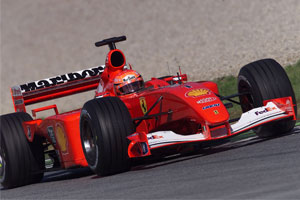Ferrari F2001

Active: 04-03-2001 - 31-03-2002
Team: Scuderia Ferrari SpA
Drivers: Michael Schumacher (1), Rubens Barrichello (2)
Team: Rory Byrne (CD), Jean Todt (TP), Ross Brawn (TD), Paolo Martinello (HE)
Team name: Scuderia Ferrari Marlboro
Ferrari went on from the championship winning F1-2000 with the same basic structure, relying on steady development of its engine and gearbox to form the core of the car. The F2001 was launched at Maranello on 29 January and debuted on track the next day at Fiorano in the hands of Michael Schumacher.
In designing the car, most of the work went into aerodynamic progress coping with the regulations that mandate a higher front wing assembly. To compensate for this front end downforce, the design team opted to design a drooping nose instead of the high nose that was so distinctive on the Ferrari F1-2000.
"There was a huge drop of downforce and efficiency in the wind tunnel when we adapted the 2000 car to suit 2001 regulations," admitted chief designer Rory Byrne, "but we've been working hard to recover that. I think slow corner performance is going to be quicker because of the advances in tyre performance whereas high speed performance won't be so affected. But every team is going to be looking for more downforce." Technical director Ross Brawn said that initially the car was two to three seconds a lap slower, but that he expected that to have been reduced to half a second by the start of the season.
Byrne reported at the car's launch that the F2001's front and rear suspension had been revised and that the chassis had put on weight due to the need to meet stringent new crash test regulations. But elsewhere weight has been shaved off the car, so the penalty hasn't been great.
"Although the basic layout of front and rear suspension remains unchanged, there has been a fundamental review of all the major suspension components and many components including front wishbones and uprights have been manufactured using new methods."
Paolo Martinelli, director of the engine department, said that his new 050 engine was also a derivative of last year's winning unit. "Typically," he said, "we have tried to reduce weight, reduce the dimensions and increase power, while trying to maintain the engine's response and reliability. It has an all new crankcase in cast aluminium and we have managed to redesign the heads to make them shorter. We have also used new materials and we have optimised our lubricants.
We have revised the entire structure of the engine, so that its main components are therefore new. The engine block was produced with a refined micro-casting process. The heads are more compact and lowered, the camshafts and crankshaft have been redesigned from a clean sheet of paper. Furthermore, we have introduced some innovative materials, employing them where best suited to specific applications. This has resulted in an overall reduction of 8% in weight when compared with its predecessor."
The gearbox initially remained largely the same as that of 2000, apart from some lubrication improvements while the team was designing an all new gearbox to be introduced later in the year.
The car proved very successful, even though it did not have an engine quite as powerful as the BMW fitted in the back of the Williams FW23. At the end of the year, Schumacher had scored a then-record 123 points, missing out on the podium only at three races, two of which due to retiring from the race. Rubens Barrichello failed to win but recorded 10 podiums as well during 2001, making it also a fairly clear contructors' victory for Scuderia Ferrari.
The Italian team went on to compete with a modified version of the F2001 in the beginning of 2002 as well, with Schumacher adding another victory by finishing first at the Australian Grand Prix. The German finished 3rd in the next race again before getting the all new Ferrari F2002 at Brazil. Barrichello still competed in his home race with the F2001 before he too got the impressive F2002 at San Marino.
Specifications
Front Suspension: Independent, push-rod activated torsion springs
Rear Suspension: Independent, push-rod activated torsion springs
Brakes: Carbon-Carbon on all four disks
Length: 4.445 mm
Width: 1.796 mm
Height: 959 mm
Front Track: 1.470 mm
Rear Track: 1.405 mm
Kerb Weight (with water and oil): 600 Kg with water, lubricant and driver
Tyres: Bridgestone
Wheels: 13" BBS (front and rear)
Transmission: Rear-wheel drive, longitudinal semi-automatic sequential electronically controlled gearbox, limited-slip differential, 7 gears + reverse
Chassis: carbon -fibre and composite honeycomb
Engine
 Designation: Ferrari tipo 050
Designation: Ferrari tipo 050
Configuration: 90° V10
Displacement: 2.997cc
Weight: 94 kg
Fuel & Lubricant: Shell
Timing Gear: 40 valves
Fuel Feed: Magneti Marelli digital electronic injection
Ignition: Magneti Marelli digital electronic ignition
